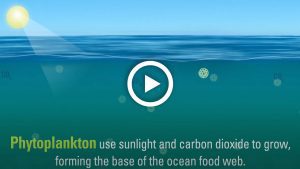The amount of carbon that reaches the deep ocean is controlled by the biology, the life, in the twilight zone. Heat-trapping carbon dioxide in the atmosphere is converted in the ocean to organic carbon that ends up trapped thousands of feet below the surface. This so-called biological pump draws down the greenhouse gas that warms Earth’s climate.
The “pump” is really a multi-step process.
In sunlit surface waters, tiny plantlike organisms called phytoplankton use energy from the sun to transform carbon dioxide into the food that allows them to grow. To get down deep, carbon first has to pass through the twilight zone—much of it as part of an underwater blizzard of bioluminescent detritus known as marine snow. That “snow” consists of flocculent clumps of dead plankton, shells, fecal pellets, bacteria, and other particles, which provide food for mesopelagic invertebrates and fish.
About 90 percent of the carbon that makes it into the mesopelagic is eaten and stays there, but a small portion sinks down deeper.
If it gets down deep enough, it’s not mixed back to the atmosphere, and it’s removed for up to thousands of years in the deep ocean. There’s potentially a small fraction that gets buried for tens of thousands of years, or millennia.
Used in Oceanus magazine, Vol. 54, No. 1, pg. 19. (Illustration by Eric S. Taylor, © Woods Hole Oceanographic Institution).
https://www.whoi.edu/oceanus/feature/mission-to-the-ocean-s-twilight-zone/
Image and Visual Licensing
WHOI copyright digital assets (stills and video) contained on this website can be licensed for non-commercial use upon request and approval. Please contact WHOI Digital Assets at images@whoi.edu or (508) 289-2647.









